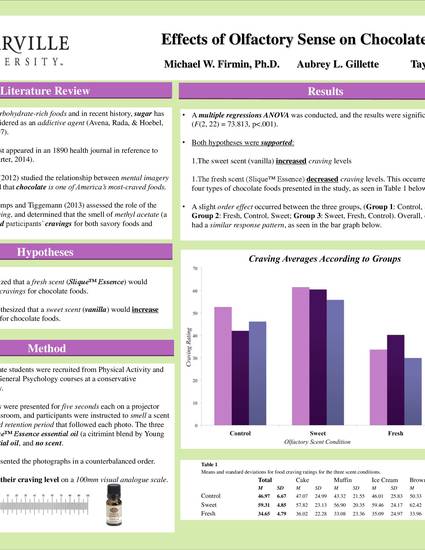
- Craving,
- olfactory,
- chocolate
Chocolate has been referred to as one of the most socially acceptable addictions. It is one of America’s most craved foods, and women tend to crave it more frequently than men. Kemps and Tiggemann (2013) conducted an innovative experiment to reconcile the ideas of mental imagery, scent, and craving. After presenting images of sweet foods and having female undergraduate students smell a neutral scent, the researchers found that the neutral smell decreased craving for sweet foods.
In the present study, researchers sought to replicate many aspects of Kemps and Tiggemann’s design. This new study went one step further, though: in addition to anticipating that a neutral or fresh scent would reduce one’s craving level, there was also an anticipation that smelling a sweet scent would increase craving levels. To test the research hypothesis, female undergraduate students received three smell conditions (no scent, fresh scent, and sweet scent) in the experiment. The order of the three conditions was counterbalanced. In all conditions, the students were shown a series of 12 images of chocolate food (cakes, muffins, ice cream, and brownies) on a large projector screen. Each image appeared for five seconds and was followed by an eight second retention period, during which participants were instructed to smell one of the essential oils. The students inhaled Slique essential oil in the fresh scent condition, inhaled vanilla essential oil in the sweet scent condition, and inhaled no essential oil in the control condition. After inhaling the scent, the students were asked to rate their craving level for the food just presented in the image on a 100 mm visual analogue scale.
An analysis based on the 93 participants’ craving responses revealed a significant effect of the olfactory conditions, (F=73.813, p<.001). That is, the students’ level of craving for chocolate food was higher in the sweet scent condition (M=59.31, SD=4.85), but lower in the fresh scent condition (M=34.65, SD=4.79), compared to the control condition (M=46.97, SD=6.67). These findings are important for a variety of populations including practitioners, nutritionists, and individuals seeking to curb their cravings or lose weight.
Available at: http://works.bepress.com/michael_firmin/331/
